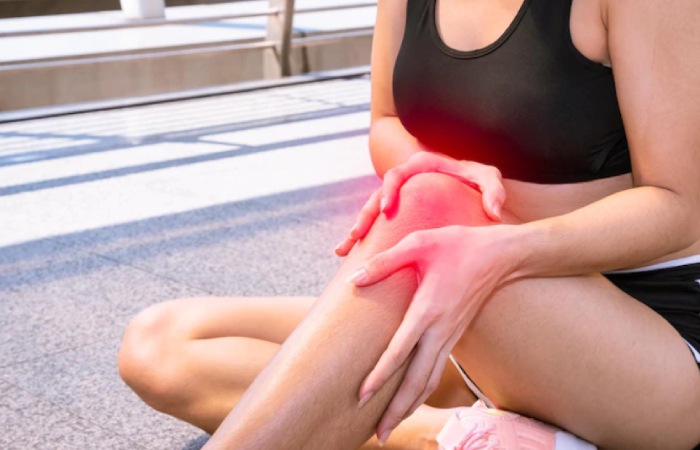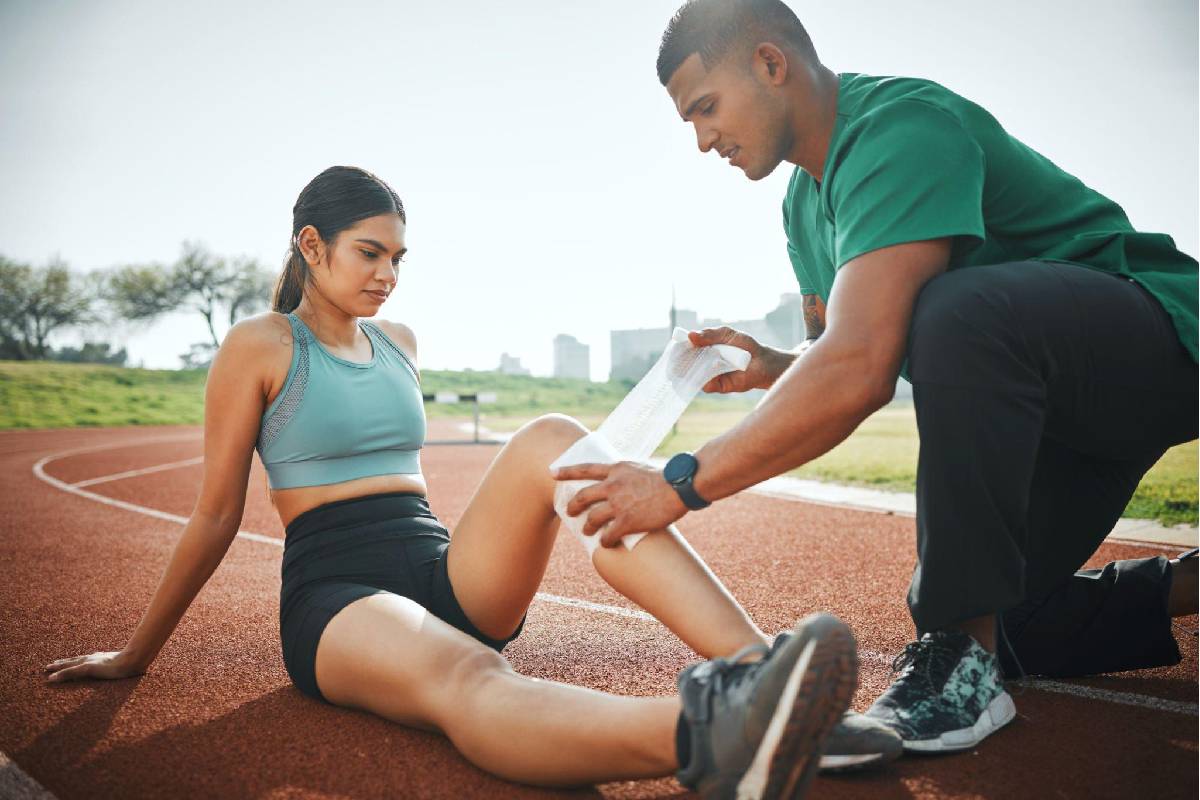Knee Sprain: How To Resume Sport Smoothly After Such A Disabling Injury – Focus on the types of sports activities recommended after a knee injury
A knee injury is not trivial, and it is crucial to take it easy and calmly resume your sports activities. So today, we successfully go over the tips and, on the contrary, the wrong ideas for getting back to sport well after a knee injury.
Table of Contents
Knee Sprain Symptoms

Disability can be almost immediate, caused by pain and swelling, sometimes appearing 1 to 4 hours after the trauma. However, the fact that it is almost immediate does not allow us to conclude that it is a severe injury.
Some patients report that the knee “gave in”, and a popping sound can be heard that strongly suggests a tear of one of the menisci.
A rule to remember is that if the pain is on the same side as the blow, it should only be a bruise, and the pain will tend to disappear quickly. However, if the pain is on the side opposite the impact, it is likely a more severe injury.
As a rule, when there is an injury, there is pain and muscle contracture, and it is often greater in partial ligament ruptures, as there is greater activation of pain receptors in the structures involved.
When there is rapid swelling, in 80 to 90% of cases, it translates into a rupture of the anterior cruciate ligament, associated or not with injury to other structures. This swelling results from bleeding into the joint (haemarthrosis).
- right knee sprain icd 10
left knee sprain icd 10
The Knee Sprain , A Complex Traumatic Area
The knee is a collection of joints, tendons, cartilage, and ligaments that are extremely sensitive to shock, which can cause your athletic training to stop following a fall suddenly.
Without going into technical and medical details, the knee is a complex area requiring rehabilitation by a physiotherapist and a slow recovery before returning to sport.
Knee Trauma: Sports Activity Made Impossible?
Mild sprain of the knee or an actual rupture of the ligament, the intensity of the trauma determines the degree of damage. It indicates of your recovery time before returning to the sport as before.
- Internal ligament sprain: This usually occurs when the knee suddenly moves inward.
- Outer ligament sprain: This usually occurs when the knee is subjected to a sudden outward shock.
- Cruciate ligament sprain, the most common pathology of footballers: the cruciate ligaments can be affected in addition to one of the two lateral ligaments. It could be a simple sprain or an actual rupture of the cruciate ligaments, a ligament trauma that will keep you bedridden for weeks.
- Other common injuries include dislocation of the patella, meniscus / meniscus injury… traumatic shocks that often require surgery.
- Also Read: Techyhit – Digital Marketing Search Engine Optimization Tools
Our Advice For Returning To Sports After A Knee Sprain
A knee injury is not trivial. It is essential to take it easy and calmly resume your sports activities. So today, we successfully went over the tips and, on the contrary, the wrong ideas for getting back to sport well after a knee injury.
The Knee, A Complex Traumatic Area
The knee is a collection of joints, tendons, cartilage, and ligaments that are extremely sensitive to shock, which can cause your athletic training to stop following a fall suddenly.
Without going into technical and medical details, the knee is a complex area requiring rehabilitation by a physiotherapist and slow healing before returning to sport.
Knee Trauma: Sports Activity Made Impossible?
Mild sprain of the knee or a fundamental rupture of the ligament, the intensity of the trauma determines the degree of damage. It indicates of your recovery time before returning to the sport as before.
- Internal ligament sprain: Usually occurs when the knee suddenly moves inward.
- Outer ligament sprain: This usually occurs when the knee is subjected to a sudden outward shock.
- Cruciate ligament sprain, the most common pathology of footballers: the cruciate ligaments can be affected in addition to one of the two lateral ligaments. It could be a simple sprain or an actual rupture of the cruciate ligaments, a ligament trauma that will keep you bedridden for weeks.
- Other common injuries include dislocation of the patella, meniscus / meniscus injury… traumatic shocks that often require surgery.
Our Advice For Returning To Sports After A Knee Sprain
A knee trauma is a real obstacle to getting back to the sport, even after months of being pampered by your physiotherapist. What to do about this pain reappearing after running, slow when walking had become possible again without any problem? How to treat a knee injury and get back in shape without risking hurt again?
Make Sure You Are Completely Healed Before Resuming Exercise
To know if the wound is really healed .. there is not a multitude of choices! You often have to try and see what happens .. Not necessarily ideal in this kind of situation, but there are no other solutions. Sports advice that may seem like a boat to you remains essential: avoid skipping steps at the risk of relapse and having to resume an appointment with your physiotherapist.
A word of advice: analyze your pain. If your knee is sore before you start to resume sports, don’t dream, you are not ready yet. If it comes back when you renew your sports training, stop to make the situation worse.
Return To Sport And Knee Injury: Listen To Your Body And Resume Sport Gradually
The best program to get back into shape after a knee injury is to resume gradually, without straining. In this second case it passes or it breaks… and there, it is already too late! Smooth recovery is essential, rather than testing how well it holds.
Depending on how long you stop practicing sports and the severity of your knee injury, returning to sports following a knee injury is a gradual process. Slowly resume sport: only five minutes on D-day and gradually more intensely. Do you think it’s very short? Caution is the mother of safety ! Plan, among other things, three short sessions of exercise as of your week of recovery, resuming a languid pace and gradually increasing the duration and intensity to accustom your knee to the physical exertion again.
To Avoid Additional Injuries: Pay Attention To The First Four Weeks
Four weeks is the time it takes to resume sporting activity after a knee injury for those who do not want to take the risk of relapse. With Featness, the app goes at your own pace, you decide the direction and pace of your sports training. In short, a hyper progressive sports training program to not stress your muscles, tendons, and joints.
During this delicate period, you can use prevention methods of treating injuries. Notably, an ice pack on a tendon has inflamed to prevent a return. It can also mean wearing a protective accessory on the affected area: knee brace, harness, and a gentle return from sports activity to avoid straining your knee. As soon as you return to formal training, you don’t want to keep any artifice unless your doctor or physiotherapist advises you, of course!
What Sports To Practice For The Rehabilitation Of Your Knee Sprain?
- Aquatic gymnastics and its many derivatives ( aqua fitness, aqua stretching, etc.) work and maintain the muscle tone of your knee, which has been dramatically affected following your injury. This type of sports practice during a sports rehabilitation program.
- Swimming: walking in water, pedaling in water to work on the joints … water is beneficial for re-educating your knee after a sports injury or following an operation. It also helps you relax and let go of an injury plaguing you for weeks. To be able to enjoy it, you need to be able to “lock” your knee, that is to approximately to be able to walk with a stiff leg, without a crutch, in complete confidence, from the locker room to the pool ladder.
- Yoga: A gentle gymnastic practice, yoga will help you reclaim your body after several weeks of not moving without suffering. Yoga enables you to regain muscle tone in your knees after several weeks of not working it.
- Cycling: particularly recommended for re-athletic training following a sprained knee; this physical activity allows you to strengthen your legs while keeping the knee in line. The bike works, in particular your cardio and your endurance.
Two Mistakes To Avoid When Returning To Sport After A Knee Sprain
It may be strange, but the first step in fighting knee pain is avoiding masking the pain. Painkillers or anti-inflammatory drugs shouldn’t make you feel so easy that you put too much strain on your still fragile knee. The use of anti-inflammatory medications was reasonable during acute pain following the accident. Once the rehabilitation period is over, thanks to physiotherapy, your body‘s warning signals are valuable clues to analyze and remove by changing the method and not with chemical aid.
Equipment supposedly overprotective
The 2nd mistake is to think that your sports equipment will protect you from new knee sprains. Sports shoe dealers are riding this legend that it is necessary to protect the ankle and knee joints by wearing high-top shoes with thick soles. Quite the contrary! Instead, it is better to wear low shoes with thin soles. It is best to scramble all the sensory information so precious to muscles and ligaments to truly adapt to movement.
Four Tips To Avoid Knee Pain After Returning To Sport
- Guards as a benchmark that each session must end without difficulty felt on the knee. So you have to spare your knee as if it were the apple of your eye. Don’t overexert yourself at the risk of regretting it.
- Some slight pain may appear after you resume sports. Don’t worry: your knee is working. It is normal to feel a bit painful when you recover from months of being off. Our advice: apply ice to your knee with a cloth for at least 15 minutes to relieve pain.
- Walking for at the smallest an hour a day allows the thighs to build up gradually.
- Hydrate regularly: We can never repeat it enough, but hydration promotes recovery.
Last Tip: The Weight Loss Food Plan, Your Ally For Your Recovering Knee
Weight gain is an aggravating factor in a sprained knee. Fitness offers you, in addition to a training program adapted to your sports recovery following an injury,
Also Read: Liver Health Formula Review And How It Helps For Liver

